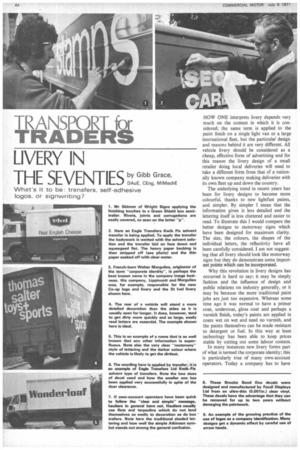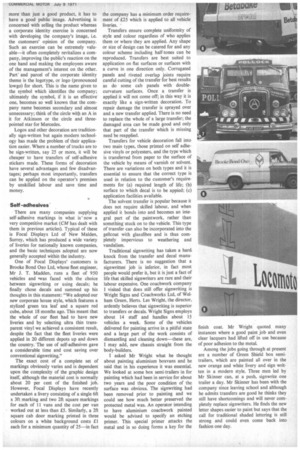HOW ONE interprets livery depends•very much on the context in
Page 46

Page 47

If you've noticed an error in this article please click here to report it so we can fix it.
which it is considered; the same term is applied to the paint finish on a single light van or a large international fleet, but the particular) design and reasons behind it are very different. All vehicle livery should be considered as a cheap, effective form of advertising and for this reason the livery design of a small retailer doing local deliveries will need to take a different form from that of a nationally known company making deliveries with its own fleet up and down the country.
The underlying trend in recent years has been for livery designs to become more colourful, thanks to new lightfast paints, and simpler. By simpler I mean that the information given is less detailed and the lettering itself is less cluttered and easier to read. To illustrate this I would compare the better designs to motorway signs which have been designed for maximum clarity. The size, the colours, the shapes of the individual letters, the reflectivity have all been carefully considered. I am not suggesting that all livery should look like motorway signs but they do demonstrate some important points which can be incorporated.
Why this revolution in livery designs has occurred is hard to say; it may be simply fashion and the influence of design and public relations on industry generally, or it may be because the more traditional paint jobs are just too expensive. Whereas some time ago it was normal to have a primer coat, undercoat, gloss coat and perhaps a varnish finish, today's paints are applied in coats wet on wet and need no varnish, and the paints themselves can be made resistant to detergent or fuel. In this way at least technology has been able to keep prices stable by cutting out some labour content.
In many instances new livery forms part of what is termed the corporate identity; this is particularly true of many own-account operators. Today a company has to have more than just a good product, it has to have a good public image. Advertising is concerned with selling the product whereas a corporate identity exercise is concerned with developing the company's image, i.e. the customers' opinion of the company. Such an exercise can be extremely valuable—it often completely revitalizes a company, improving the public's reaction on the one hand and making the employees aware of the management's interest on the other. Part and parcel of the corporate identity theme is the logotype, or logo (pronounced lowgo) for short. This is the name given to the symbol which identifies the company; ultimately the symbol, if it is an effective one, becomes so well known that the company name becomes secondary and almost unnecessary; think of the circle with an A in it for Atkinson or the circle and threepointed star for Mercedes.
Logos and other decoration are traditionally sign-written but again modem technology has made the problem of their application easier. Where a number of trucks are to be sign-written, say 25 or more, it will be cheaper to have transfers of self-adhesive stickers made. These forms of decoration have several advantages and few disadvantages; perhaps most importantly, transfers can be applied on the operator's premises by unskilled labour and save time and money.
Self-adhesives' There are many companies supplying self-adhesive markings in what is' now a very competitive market (CM has dealt with them in previous articles). Typical of these is Focal Displays Ltd of New Malden, Surrey, which has produced a wide variety of liveries for nationally known companies, and the basic techniques adopted are now generally accepted within the industry.
One of Focal Displays' customers is Brooke Bond Oxo Ltd, whose fleet engineer, Mr J. T. Madden, runs a fleet of 950 vehicles and .was faced with the choice between signwriting or using decals; he finally chose decals and summed up his thoughts in this statement: "We adopted our new corporate house style, which features a stylized green tea leaf and a square red cube, about 18 months ago. This meant that the whole of our fleet had to have new liveries and by selecting ultra thin transparent vinyl we achieved a consistent result, despite the fact that the fleet liveries were applied in 20 different depots up and down the country. The use of self-adhesives gave a considerable time and cost saving over conventional signwriting."
The exact cost of a complete set of markings obviously varies and is dependent upon the complexity of the graphic design itself, although the material cost is normally about 20 per cent of the finished job.
However, Focal Displays have recently undertaken a livery consisting of a single 6ft x 3ft marking and two 2ft square markings
for each of 11 vans and the cost per van
worked out at less than £5. Similarly, a 2ft square cab door marking printed in three colours on a white background costs £1 each for a minimum quantity of 25—in fact the company has a minimum order requirement of £25 which is applied to all vehicle liveries. '
Transfers ensure complete uniformity of style and colour regardless of who applies them or where they are applied. Any shape or size of design can be catered for and any colour scheme including half-tones can be reproduced. Transfers are best suited to application on fiat surfaces or surfaces with a curve in one direction only. Corrugated panels and riveted overlap joints require careful cutting of the transfer for best results as do some cab panels with doublecurvature surfaces. Once a transfer is applied it will not come off; in this way it is exactly like a sign-written decoration. To repair damage the transfer is sprayed over and a new transfer applied. There is no need to replace the whole of a large transfer; the damaged area can be made good and only that part of the transfer which is missing need be reapplied.
Transfers for vehicle decoration fall into two main types, those printed on self adhesive vinyls or polyesters, and the type which is transferred from paper to the surface of the vehicle by means of varnish or solvent. There are variations on both types and it is essential to ensure that the correct type is used in relation to the customer's requirements for (a) required length of life; (b) surface to which decal is to be appied; (c) application facilities available.
The solvent transfer is popular because it does not require skilled labour, and when applied it bonds into and becomes an integral part of the paintwork, rather than something' stuck on to the vehicle. This type of transfer can also be incorporated into the gellcoat with glassfibre and is thus completely impervious to weathering and vandalism.
Traditional signwriting has taken a hard. knock from the transfer and decal manufacturers. There is no suggestion that a signwritten' job is inferior, in fact most people would prefer it, but it is just a fact of life that skilled signwriters are rare and their labour expensive. One coachwork company 1 visited that does still offer signwriting is Wright Signs and Coachworks Ltd, of Welham Green, Herts. Les Wright, the director, ardently believes that signwriting is superior to transfers or decals. Wright Signs employs about 14 staff and handles about 15 vehicles a week. Some of the vehicles delivered for painting arrive in a pitiful state and a large part of the work consists of dismantling and cleaning down—these are, I may add, new chassis straight from the body-builders.
I asked Mr Wright what he thought about painting aluminium boxvans and he said that in his experience it was essential. We looked at some box semi-trailers in for painting which had been in service for about two years and the poor condition of the surface was obvious. The signwriting had been removed prior to painting and we could see how much better preserved the protected metal was. An operator intending to have aluminium coachwork painted would be advised to specify an etching primer. This special primer attacks the metal and in so doing forms a key for the finish coat. Mr Wright quoted many instances where a good paint job and even clear lacquers had lifted off in use because of poor adhesion to the metal.
Among the jobs going through at present are a number of Green Shield box semitrailers, which are painted all over in the new orange and white livery and sign written in a modern style. Three men led by Mr Skinner can, at a push, signwrite one trailer a day. Mr Skinner has been with the company since leaving school and although he admits transfers are good he thinks they still have shortcomings and will never completely replace signwriters. He finds the new letter shapes easier to paint but says that the call for traditional shaded lettering is still strong and could even come back into fashion one day.












































































































































